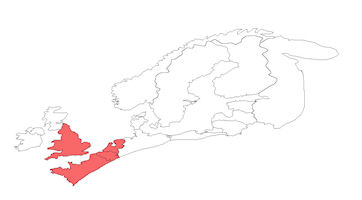
|  |
 |
 [Legend] |
 |

|  |
 |
 [Legend] |
 |
Type 3 comprises combs with a purpose-designed terminal hand-hold. It thus incorporates both 'asymmetric' and 'handled' combs (see Alexander 1987; Hodges 1980; MacGregor 1985, 87, 91-2; Riddler 1990a; Riddler 1998). In England, one may note two classes of handled comb (both dated to between the 8th and 11th centuries: Riddler 1990a); these may be termed 'northern' and 'southern' technologies (though their distributions are not mutually exclusive). The distinction lies in the means by which the handle is formed: in the south it is more common for toothplates to be secured within a slotted antler tine, while in the north the handle is often constructed using a pair of connecting plates, as is common on other forms of composite comb; see Alexander 1987; Riddler 1990a, 9; 1998, 189).
In continental Europe, a slightly different form is encountered: the asymmetric comb. These combs are distinguished by the presence of an endplate that lacks teeth, allowing it to act as something of a terminal handhold (Roes 1963, plate 29). In addition to their continental distribution, a small number of examples are known from Scandinavia (e.g. Birka: Ashby 2006, appendix plate 8b). The type dates to the 8th and 9th centuries so that, for a period, handled and asymmetric combs were in contemporaneous use, and may be seen as skeuomorphs (see Riddler 1998, 189). Their particular associations have been discussed elsewhere (Alexander 1987; Hodges 1980; Riddler 1990a; Riddler 1998), and there is potential for further study, but in the interest of brevity they are considered here as a single group.
The comments facility has now been turned off.
© Internet Archaeology/Author(s)
University of York legal statements | Terms and Conditions
| File last updated: Tue Sep 20 2011